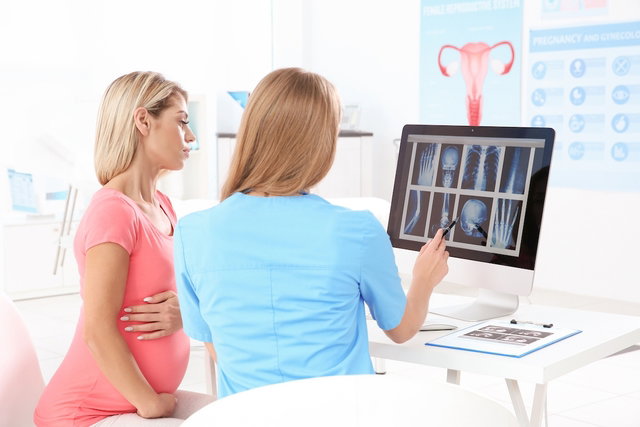X-rays during pregnancy are considered safe, as long as they are performed under medical advice and do not exceed the maximum recommended radiation. Furthermore, the correct use of the lead apron on the belly is important to prevent radiation from reaching the baby.
Generally, the maximum recommended radiation during pregnancy is 5 rads or 5000 millirads, which is the unit used to measure the amount of radiation absorbed, because beyond this value the fetus can undergo changes.
Therefore, when the X-ray uses greater radiation than recommended or too many X-ray exams are performed during pregnancy, there is an increased risk of fetal malformations, growth restriction or diseases.

Is it safe to have an X-ray during pregnancy?
Taking X-rays during pregnancy is considered safe, as long as the maximum radiation of 5 rads is respected and the lead apron is well positioned in the belly area.
This is because most exams that use X-rays are far from reaching the maximum value, being considered extremely safe, especially if only 1 to 2 exams are carried out during pregnancy.
However, the direction of radiation is also important, and abdominal X-rays in the belly region should be avoided as much as possible.
In any case, the doctor, when recommending the X-ray, which should only be done when necessary, must evaluate the benefits of the exam for the woman and the possible risks for the fetus.
What are the risks
Exposure to high doses of radiation during pregnancy may increase the risk of:
- Malformations;
- Congenital defects;
- Fetal growth restriction;
- Intellectual disability;
- Childhood leukemia.
However, these problems vary according to gestational age and length of exposure to radiation, and are rare because a very high amount of radiation is needed to cause changes in the fetus.
Furthermore, exposure to high radiation in the belly area in the first 15 days after conception can increase the risk of miscarriage.
Radiation table by type of x-ray
Depending on the location on the body where the X-ray is taken, the amount of radiation varies:
* 1000 millirads = 1 rad
Therefore, the pregnant woman can have an X-ray whenever recommended, however, it is advisable to inform the doctor about the pregnancy, so that the lead apron used to protect against radiation is correctly positioned on the pregnant woman’s belly.
Is it dangerous to have an X-ray without knowing you are pregnant?
In cases where the woman did not know she was pregnant and had an X-ray, the exam is also not dangerous, even at the beginning of pregnancy when the embryo is developing. This is because the radiation emitted by the devices is very low.
However, it is recommended that, as soon as she discovers she is pregnant, the woman informs the obstetrician about the number of tests she has undergone, so that the amount of radiation already absorbed can be calculated, avoiding that during the remainder of the pregnancy she receives more than 5 rads. .
What can happen if you are exposed to more radiation than recommended
The defects and malformations that can appear in the fetus vary according to the gestational age, as well as the total amount of radiation to which the pregnant woman was exposed. However, when it does happen, the main complication of radiation exposure during pregnancy is usually the development of cancer during childhood.
Therefore, babies born after extensive exposure to radiation should be frequently evaluated by a pediatrician to identify early changes and even initiate some type of treatment, if necessary.

Sign up for our newsletter and stay up to date with exclusive news
that can transform your routine!
Warning: Undefined array key "title" in /home/storelat/public_html/wp-content/plugins/link-whisper-premium/templates/frontend/related-posts.php on line 12
Warning: Undefined array key "title_tag" in /home/storelat/public_html/wp-content/plugins/link-whisper-premium/templates/frontend/related-posts.php on line 13



